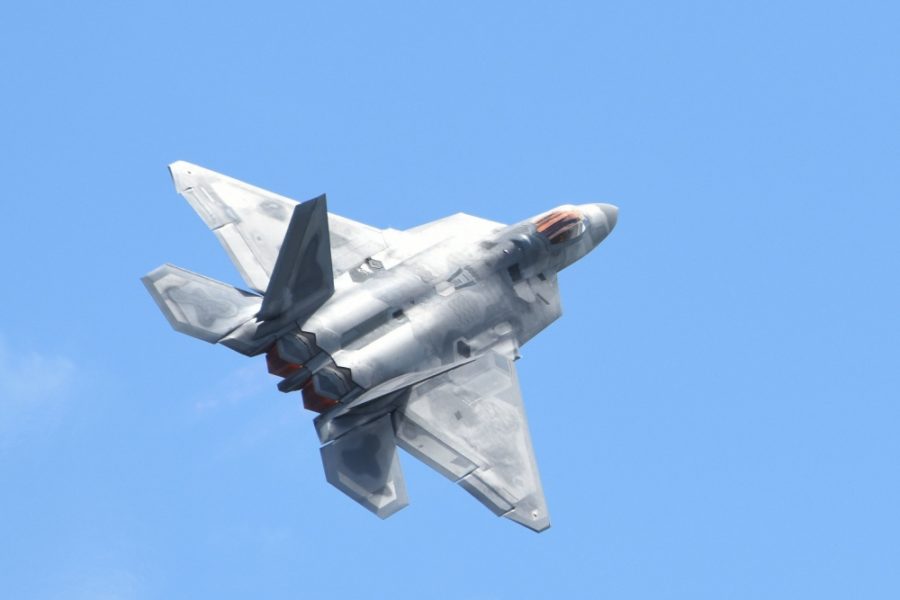The F-22 is a stealthy, penetrating, air dominance fighter built for day, night, and adverse weather, full-spectrum operations.
The prototype YF-22 first flew as part of USAF’s Advanced Tactical Fighter competition on Sept. 29, 1990, followed by the flight of the first F-22 test aircraft in 1997. The Raptor debuted in combat striking Islamic State ground targets during Inherent Resolve in 2014, and achieved its first air-to-air kill downing a Chinese surveillance balloon off the coast of North Carolina on Feb. 3, 2023.

Raptor is currently the world’s most advanced fighter and its mix of stealth, long-range supercruise, and multitarget engagement capability make it a key platform in USAF’s Indo/Asia-Pacific strategy. F-22’s advanced flight controls and high-performance thrust-vectoring engine enable extreme maneuverability. Features include six LCD color cockpit displays, APG-77 AESA radar, EW system with RWR and missile launch detection, and advanced comm/navigation and data links.
USAF is aggressively testing enhancements to ensure the F-22’s “first-shot, first-kill” advantage against advanced threats until replaced or augmented by the F-47 Next-Generation Air Dominance (NGAD) fighter in the 2030s. Combat-coded aircraft recently completed Increment 3.2B software upgrades adding high-resolution ground-mapping SAR, threat geolocation, EA capability, and integrated SDB I, AIM-120D, and AIM-9X. The program employs an “agile” strategy to continuously develop, test and rapidly field improvements, including rolling NGAD technologies back into the Raptor.
Ongoing efforts include a distributed IRST system to stealthily track and target airborne threats, stealthy external fuel tanks/pylons to extend unrefueled range, and AIM-260 Joint Advanced Tactical Missile testing, radar electronic hardening, and jam-resistant navigation. Other significant efforts include the Reliability, Availability, and Maintainability Program (RAMP), Link 16, IFF enhancement, and engine reliability and performance improvements. RAMP improves electrical power, replaces avionic-fiberoptics, adds more durable LO, and fixes structures and wiring. Link 16 will enable two-way networking with legacy aircraft via Multifunctional Information Distribution System/Joint Tactical Radio System (MIDS/JTRS). Initial installs began in FY22 and fleetwide upgrade has been extended an additional two years to FY27.
The F-22 mission capable rate dropped to 40 percent in 2024 and USAF proposed retiring noncombat-coded Block 20 aircraft to fund NGAD development, retaining only modernized Block 30/35s. Congress blocked the move pending analysis of the costs to upgrade Block 20s to full combat capability through at least FY27. An F-22 was damaged in an unspecified mishap during exercise Sentry Savannah at Hilton Head International Airport, Ga., on May 6, 2024.
F-22 Raptor Technical Data
Contractors: Lockheed Martin; Boeing (production partner).
First Flight: Sept. 7, 1997.
Delivered: Oct. 23, 2002-May 2, 2012.
IOC: Dec. 15, 2005.
Production: 195.
Inventory: 185.
Operator: ACC, AFMC, AFRC (associate), PACAF, ANG.
Aircraft Location: Edwards AFB, Calif.; JB Elmendorf-Richardson, Alaska; JB Langley-Eustis, Va.; JB Pearl Harbor-Hickam, Hawaii; Nellis AFB, Nev
Active Variant: •F-22A. Fifth-generation air dominance fighter.
Dimensions: Span 44.5 ft, length 62 ft, height 16.6 ft.
Weight: Max T-O 83,500 lb.
Power Plant: Two Pratt & Whitney F119-PW-100 turbofans, each 35,000 lb thrust.
Performance: Speed Mach 2 with supercruise capability, ferry range 1,850+ miles with two external wing fuel tanks (farther with air refueling).
Ceiling: Above 50,000 ft.
Armament: One internal M61A2 20 mm gun (480 rds); two AIM-9 Sidewinders inside internal weapons bays; six AIM-120 AMRAAMs (air-to-air loadout) or two AIM-120s and two GBU-32 JDAMs or eight SDBs (air-toground loadout) in main internal weapons bay.
Accommodation: Pilot on ACES II zero/zero ejection seat.


